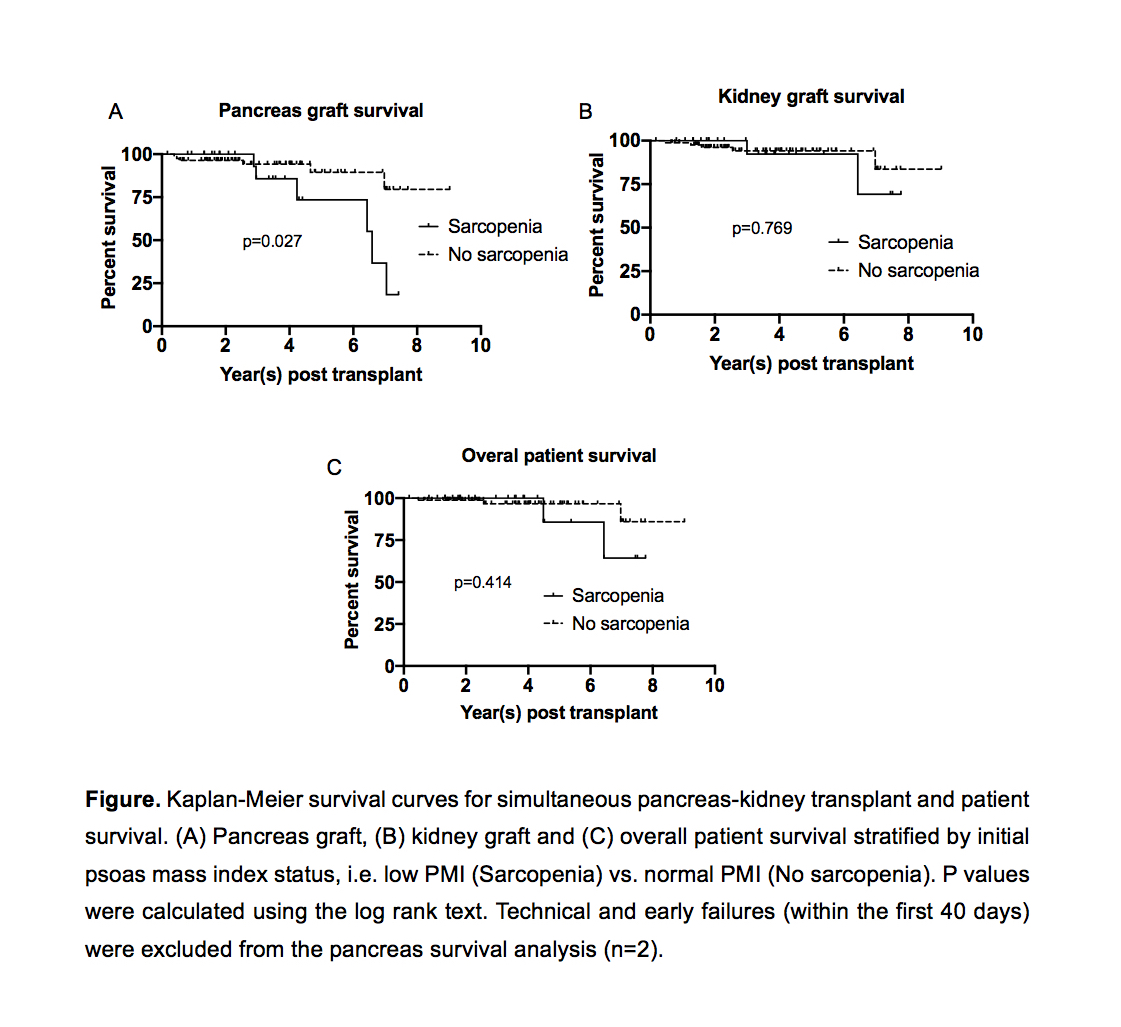Impact of Sarcopenia on Simultaneous Pancreas and Kidney Transplantation Outcomes: A Retrospective Observational Cohort Study
Transplant Surgery, University of California San Francisco, San Francisco, CA
Meeting: 2020 American Transplant Congress
Abstract number: C-331
Keywords: Graft survival, Kidney, Outcome, Pancreas
Session Information
Session Name: Poster Session C: Pancreas and Islet: All Topics
Session Type: Poster Session
Date: Saturday, May 30, 2020
Session Time: 3:15pm-4:00pm
 Presentation Time: 3:30pm-4:00pm
Presentation Time: 3:30pm-4:00pm
Location: Virtual
*Purpose: Sarcopenia has been identified as a recognized predictive variable for surgical outcomes. We hypothesized that sarcopenia could be a key measure to identify frail patients and predict potential poor outcomes among recipients of simultaneous pancreas and kidney transplants (SPK).
*Methods: We estimated sarcopenia by measuring psoas muscle mass index (PMI). PMI was assessed on preoperative computed tomography (CT) scans of SPK recipients between 2010 and 2018 and normalized to height. Low PMI was defined as a value in the lowest sex-specific quartile.
*Results: Of the 137 patients identified within the study period, 109 had a perioperative CT scan available for analysis. The median follow-up was 3 years (range 0.2 – 9 years). Twenty-five patients had a low PMI and 84 patients had a normal PMI. Patient characteristics were not statistically significant different between the two groups with the exception of body mass index, which was significantly lower in low PMI group (p=0.001). Patients with low PMI had significantly lower pancreas graft survival (p=0.027), while patient and kidney graft survival were not statistically different between groups (p=0.769 and p=0.414, respectively) (Figure A-C). A multivariate Cox regression analysis revealed that low PMI and PRA>20% were independent risk factors for pancreas graft failure (p=0.012 and 0.042, respectively). The leading cause of pancreas graft loss in the low PMI group was rejection, compared to vascular complications in the normal PMI group. Among low PMI patients who had a follow up CT scan, 62.5% (5/8) of those with a functional pancreas graft either improved or resolved sarcopenia whereas 75.0% (3/4) of those who lost their pancreas graft continued to lose muscle mass.
*Conclusions: Sarcopenia could represent one of the predictors of pancreas graft failure and should be evaluated and potentially optimized in SPK recipients.
To cite this abstract in AMA style:
Meier RP, Noguchi H, Kelly Y, Sarwal M, Conti G, Halleluyan R, Tavakol M, Stock P, Freise C. Impact of Sarcopenia on Simultaneous Pancreas and Kidney Transplantation Outcomes: A Retrospective Observational Cohort Study [abstract]. Am J Transplant. 2020; 20 (suppl 3). https://atcmeetingabstracts.com/abstract/impact-of-sarcopenia-on-simultaneous-pancreas-and-kidney-transplantation-outcomes-a-retrospective-observational-cohort-study/. Accessed December 23, 2025.« Back to 2020 American Transplant Congress

